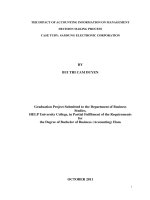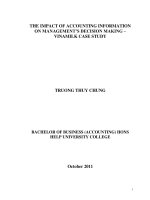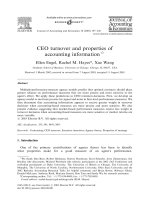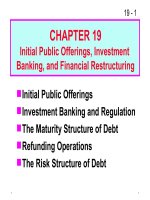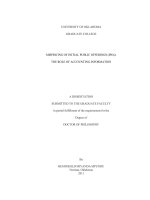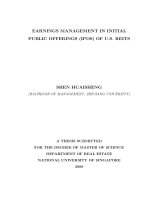Mispricing of initial public offerings (IPOs) the role of accounting information
Bạn đang xem bản rút gọn của tài liệu. Xem và tải ngay bản đầy đủ của tài liệu tại đây (2.76 MB, 85 trang )
UNIVERSITY OF OKLAHOMA
GRADUATE COLLEGE
MISPRICING OF INITIAL PUBLIC OFFERINGS (IPOs):
THE ROLE OF ACCOUNTING INFORMATION
A DISSERTATION
SUBMITTED TO THE GRADUATE FACULTY
in partial fulfillment of the requirements for the
Degree of
DOCTOR OF PHILOSOPHY
By
HEMINIGILD MIYANDA MPUNDU
Norman, Oklahoma
2011
UMI Number: 3460784
All rights reserved
INFORMATION TO ALL USERS
The quality of this reproduction is dependent on the quality of the copy submitted.
In the unlikely event that the author did not send a complete manuscript
and there are missing pages, these will be noted. Also, if material had to be removed,
a note will indicate the deletion.
UMI 3460784
Copyright 2011 by ProQuest LLC.
All rights reserved. This edition of the work is protected against
unauthorized copying under Title 17, United States Code.
ProQuest LLC.
789 East Eisenhower Parkway
P.O. Box 1346
Ann Arbor, MI 48106 - 1346
MISPRICING OF INITIAL PUBLIC OFFERINGS (IPOs):
THE ROLE OF ACCOUNTING INFORMATION
A DISSERTATION APPROVED FOR THE
MICHAEL F. PRICE COLLEGE OF BUSINESS
BY
Dr. Robert Lipe, Chair
Dr. Frances L. Ayres
Dr. Lou Ederington
Dr. Wayne Thomas
Dr. Han Yi
© Copyright by HEMINIGILD MIYANDA MPUNDU 2011
All Rights Reserved.
TABLE OF CONTENTS
LIST OF TABLES.....................................................................................................................................v
LIST OF FIGURES ..................................................................................................................................vi
ABSTRACT ........................................................................................................................................... vii
1. Introduction ...........................................................................................................................................1
2. Literature review and hypothesis development ..................................................................................... 5
2.1. Literature review ............................................................................................................................ 5
2.2. Hypothesis development ............................................................................................................... 10
2.2.1 Initial assessment: IPO overpricing and the accrual anomaly ............................................... 11
2.2.2 Further assessment: understanding more about the role of accounting in IPO overpricing.. 12
2.2.3 Role of life cycle stage ............................................................................................................ 16
3. Tests and research design .................................................................................................................... 19
3.1. Initial assessment: IPO overpricing and the accrual anomaly ..................................................... 21
3.2 Further assessment: understanding more about the role of accounting in IPO overpricing......... 23
3.2.1 Timing test .............................................................................................................................. 23
3.2.2 Association test ....................................................................................................................... 24
3.2.3 Combined test ......................................................................................................................... 25
3.3 Role of life cycle stage ................................................................................................................... 26
4. Sample ................................................................................................................................................. 28
5. Results ................................................................................................................................................. 30
5.1 Initial assessment: IPO overpricing and the accrual anomaly ...................................................... 30
5.2 Further assessment: understanding more about the role of accounting in IPO overpricing ......... 31
5.2.1 Timing test .............................................................................................................................. 31
5.2.2 Association test ....................................................................................................................... 32
5.2.3 Combined test ......................................................................................................................... 33
5.3 Role of life cycle stage ................................................................................................................... 34
5.3.1 Does life cycle have any effect on IPO mispricing beyond its effect on earnings components
(RQ1)? ............................................................................................................................................. 35
5.3.2 How does life cycle stage affect the likelihood of earnings-based explanations and other
explanations (RQ2)? ........................................................................................................................ 36
5.4 Results of Additional Tests ............................................................................................................. 39
5.4.1 Full sample tests ..................................................................................................................... 40
5.4.2 Life cycle sample tests ............................................................................................................ 41
6. Conclusion ........................................................................................................................................... 45
REFERENCES ........................................................................................................................................ 48
APPENDICES ......................................................................................................................................... 53
TABLES .................................................................................................................................................. 60
iv
LIST OF TABLES
Table 1: Selection, Industry and IPO years of Final Sample .......................................60
Table 2: Descriptive Statistics of Sample IPO Firms (full sample) ..............................62
Table 3: Initial Assessment and Correlation Matrix for the IPO variable, Accrual and
Cash Flow Ranks ..........................................................................................................63
Table 4: Discriminating between earnings-based explanations and other explanations
of IPO mispricing (using all my sample IPOs) ............................................................65
Table 5: Descriptive Statistics of Sample IPO Firms (life cycle sample) .....................67
Table 6: The role of life cycle stage (using the life cycle sample IPOs) .....................68
Table 7: Discriminating between earnings-based explanations and other explanations
of IPO mispricing (using the life cycle sample IPOs) ..................................................70
Table 8: Discriminating between earnings-based explanations and other explanations
of IPO mispricing (using all my sample IPOs and 750 post-IPO days) .......................73
Table 9: Discriminating between earnings-based explanations and other explanations
of IPO mispricing (using the life cycle sample IPOs and 750 post-IPO days) ............75
v
LIST OF FIGURES
Figure 1: Possible causes of IPO mispricing ................................................................59
vi
ABSTRACT
I examine the role of accounting information in the end-of-first day overpricing
of IPO stocks. Sloan (1996) and Teoh et al. (1998) suggest earnings-based
explanations for the mispricing while Healy and Palepu (1990) suggest a risk-based
explanation. In view of the conflicting explanations for the end-of-first-day mispricing
of IPOs from prior studies, I first examine which possible explanation (earnings-based
vs. other) is consistent with my sample IPO firms. For this task, I employ the
methodology first suggested by Bernard et al. (1997). This involves an examination of
post-IPO abnormal returns. The results of my main tests using all my sample IPO
firms suggest that, on average, the mispricing of IPOs is consistent with earning-based
explanations. That is, the mispricing arises from market participants failing to
incorporate the implication of pre-IPO earnings components for future earnings as in
Sloan (1996). However, life cycle tests discussed later suggest that this result may be
driven by growth firms.
I extend my examination to investigate the role of life cycle in IPO mispricing
since life cycle has been offered as a possible explanation (e.g., Liu 2008) but the role
of life cycle is largely unexplored. Thus, I examine possible mechanisms by which life
cycle could affect IPO pricing. I examine two specific research questions. The first
question is whether life cycle has any effect on IPO mispricing beyond affecting the
relative proportion of accruals and cash flows. In this regard, I find no evidence that
life cycle stage explains post-IPO abnormal returns, whether used alone in a regression
explaining post-IPO returns, or used together with accrual and cash flow ranks. The
second question I address is whether life cycle affects the form of mispricing
vii
(earnings-based vs. other) and I document some evidence that life cycle moderates the
type of mispricing. Specifically, the mispricing of growth- (mature-) stage sample IPO
firms is (is not) consistent with earnings-based explanations. My evidence regarding
the mispricing of decline-stage firms is mixed: the timing and associations tests
provide evidence that the mispricing of decline-stage firms is consistent with earningsbased explanations; the combined test provides evidence consistent with other
explanations. Thus, it seems that earnings play a role in the mispricing of decline stage
IPOs but not in the Sloan (1996) sense.
This evidence has implications for the role of earnings in explaining future
prospects, and hence value, of a firm. Specifically, it raises questions about why
investors seemingly do a poor job of predicting the future prospects of growth and
decline stage firms using current period earnings information when the opposite seems
to be true for mature firms. Regulators might be interested to know what disclosures
would mitigate this problem.
viii
1. Introduction
The accounting and finance literature documents evidence that shares of initial
public offering (IPO) firms are overpriced by the end of the first day of public trading,
leading to inferior long-run stock price performance of IPO firms relative to non-IPO
firms matched on size and industry (Ritter 1991, Loughran and Ritter 1995).1 This
study examines the overpricing of IPO stocks and explores a possible role for
accounting information, particularly components of earnings, to explain the
overpricing. Sloan (1996) documents evidence suggesting that companies with
relatively high accruals or low cash flows are overpriced. The evidence from Sloan
(1996) is particularly relevant for IPO firms which tend to be growth firms2 that go
public to finance investments and to fund shortfalls in operating cash flows. The
earnings of these growth firms are likely to contain a larger (smaller) proportion of
accruals (cash flows from operations) compared to earnings of firms that are not
experiencing growth and this results in more mispricing for IPO firms. Thus, I
examine a possible link between the overpricing of IPO stocks and Sloan’s (1996)
anomaly. I also examine a possible role for life cycle since prior studies of IPO
performance (e.g., Liu 2008, Ball and Shivakumar 2008) have suggested life cycle as
an omitted variable. The role of life cycle in the mispricing of IPO stocks is largely
1
Another IPO pricing anomaly that is not part of my study is that shares of IPO firms are offered to the
public at prices below fundamental values (Ibbotson et al. 1988).
2
My sample includes growth, mature, and decline stage firms. Contrary to the intuition that only
growth firms go public, mature and decline firms are likely to go public to retire debt when an increase
in business risk is imminent (e.g., Healy and Palepu 1990) or for reasons unrelated to funding
investments. Also refer to section 2.2.3 for a further discussion of why mature and decline firms go
public.
1
unexplored. Therefore, I am interested in gaining a better understanding of the role
that life cycle plays in the overpricing of IPOs.
Broadly, I classify possible explanations for the overpricing of IPO stocks into
two groups: (a) earnings-based explanations, that is, the failure by market participants
to incorporate the implications of earnings components in IPO financial statements for
future earnings as in Sloan (1996)3, or (b) other explanations. The latter group of
explanations includes failure by researchers or market participants to estimate the risk
associated with IPO stocks (as in Healy and Palepu 1990) and total failure by investors
to utilize the information in financial statements (as in Shiller 1990 and Ritter 1991).
To a large extent, both groups of explanations for IPO mispricing involve irrational
investor behavior.4 The first instance involves irrational investor behavior based on
earnings. This is likely a numerator effect (see note 3) though earnings may inform
investors about risk, a denominator effect. The second instance is irrational investor
behavior based on everything else rather than earnings. This includes a failure to
correctly estimate the risk associated with IPO firms or a total disregard of accounting
information. I discuss this in detail later. My study attempts to examine which
explanation for IPO overpricing (earnings vs. other) is consistent with the data.
Healy and Palepu (1990) provide evidence that IPOs convey information about
changes in risk rather than changes in the level of expected earnings. In other words,
Healy and Palepu (1990) provide evidence that other explanations, particularly risk,
3
This is also known as the “numerator” explanation based on a classical firm valuation model. In this
model, the value of a firm equals the sum of its expected future abnormal earnings discounted to the
present using an appropriate measure of risk. The numerator of the valuation model comprises the
expected earnings of a firm while the denominator represents a time value of money adjustment for
level of risk. Earnings is usually considered a numerator factor in mispricing; many non-earnings
factors are described as denominator factors though some could also be viewed as numerator factors.
4
The exception is researcher errors which is unrelated to investor behavior.
2
are more likely to explain IPO mispricing than earnings-based explanations.
Subsequent studies of IPO mispricing support earnings-based explanations. For
example, Teoh et al. (1998a, 1998b) report evidence that overpricing of IPOs is linked
to accruals although some controversy exists as to whether the role of accruals is
limited to cases of earnings management or is broader in scope, as in Sloan (1996).
Since prior studies produce conflicting explanations for IPO mispricing, this
study can enhance our understanding of IPO mispricing. I expect regulators to be
interested in knowing whether the documented pricing anomaly is specific to IPO
settings or a manifestation of a wider anomaly (as in Sloan 1996) which applies to all
firms. This would, for instance, help in defining the scope (IPO firms only vs. all
firms) of any financial reporting changes that are meant to address the anomaly.
Furthermore, a better understanding of the source of the mispricing (e.g., earningsbased explanations vs. other explanations) could guide both regulators and preparers
of IPO financial statements. On the other hand, the role of life cycle stage is likely to
be of interest to sophisticated investors such as mutual fund managers specializing in
securities of firms in specific life cycle stages.5 Furthermore, by using pre-IPO
financial statement information rather than the first post-IPO financial statements (as
in Teoh et al. 1998a and 1998b), I am able to make a more refined inference regarding
the role of accounting information in the mispricing of IPOs.
In tests using my full sample of IPO firms, I document evidence that, on
average, overpricing of IPO stocks recorded at the end of the first day of public
trading is consistent with earnings-based explanations. That is, earnings play a role in
5
For instance, “growth funds” are a type of mutual fund that invests in the stocks of companies that
have the potential for large capital gains; these companies are implicitly young firms in their growth
stages (Black 1998).
3
IPO mispricing similar to the one documented in Sloan (1996). My findings contrast
with Healy and Palepu’s (1990) evidence that post-IPO stock returns cannot be
explained by the revision of analysts’ earnings forecasts subsequent to the IPO and
changes in the level of earnings subsequent to the IPO date. In essence, they do not
find a role for earnings in IPO mispricing, but I do. Healy and Palepu (1990) also find
evidence of risk changes (asset and equity betas) around the IPO date. My results
cannot completely rule out that some mispricing might be related to risk but suggest
that risk is unlikely to be the sole explanation.
Regarding life cycle, I find no evidence that life cycle stage explains post-IPO
returns, whether life cycle is used alone in a returns regression or life cycle is used
together with accrual and cash flow ranks. However, in analyses that divide the sample
IPO firms into life cycles, I find evidence that life cycle affects the type of mispricing
(earnings vs. other). In particular, I find evidence that the mispricing of growth(mature-) stage IPO firms is (is not) consistent with earnings-based explanations.
Evidence relating to decline-stage IPO firms is mixed. Specifically, the timing and
association tests support earnings-based explanations for mispricing of decline-stage
IPOs while the combined test results do not. This might suggest that though earnings
play a role in the mispricing of decline-stage IPOs, the role of earnings is different in
context from Sloan (1996).
The rest of the paper proceeds as follows. Section 2 reviews the literature and
develops the hypotheses that I test. Section 3 describes my tests and research design.
Section 4 discusses the sample, section 5 presents the results and section 6 concludes.
4
2. Literature review and hypothesis development
2.1. Literature review
The accounting and finance literature documents two pricing anomalies related
to IPO firms and a third pricing anomaly related to all firms. In the first IPO anomaly,
IPO firms are offered to the market at prices below fundamental values (Ibbotson et al.
1988). In the second IPO anomaly, and focus of my study, IPO stocks are overpriced
by the end of the first day of public trading which results in IPO firms registering
inferior long-run stock price performance relative to non-IPO firms matched on size
and industry (Ritter 1991, Loughran and Ritter 1995). A third anomaly related to all
firms suggests that stock prices do not fully reflect the information about future
earnings contained in current period earnings components (Sloan 1996). Stated
differently, the evidence in Sloan (1996) suggests that cash flows are underpriced
and/or accruals are overpriced. Dechow and Schrand (2004) provide an overview of
the literature relating to Sloan’s (1996) anomaly.
Prior studies of the mispricing and subsequent underperformance of IPO firms
can be grouped into two categories. The first category comprises studies that attribute
IPO mispricing to earnings, in particular to the weights attached to components of
earnings. Within this group, a number of studies examine arguments for and against a
possible role of earnings management in the mispricing. For example, Teoh et al.
(1998a and 1998b) provide some evidence in support of an earnings management
hypothesis whereas Ball and Shivakumar (2008) and Armstrong et al. (2009) provide
some evidence that contradicts the earnings management hypothesis. The second
category comprises studies that attribute IPO mispricing and underperformance to
5
factors other than earnings. This latter group includes studies that attribute the
mispricing of IPO stocks to risk factors and what has come to be known as “fads”
(investors being unjustifiably optimistic about the future prospects of a particular firm
or industry). A growing number of studies examine life cycle as a possible alternative
explanation for some of the key observations from the earnings management literature
(e.g., Black 1998, Liu 2008, Ball and Shivakumar 2008). I discuss the prior studies in
detail below.
Shiller (1990) provides a behavioral perspective on IPO mispricing and
suggests that “firms go public when investors are irrationally overoptimistic about the
future potential of certain industries.” In other words, managers time the listing of
firms to exploit investor sentiment. In a related study, Ritter (1991) examines the
returns to a strategy of investing in IPO stocks at the close of public trading on the IPO
date and holding the IPO stocks for 3-years. He documents 3-year holding period
returns of about 34% for IPO firms compared to 62% for size- and industry-matched
non-IPO firms.6 Ritter (1991) also finds that younger companies and companies going
public in high volume years perform worse than average. He examines whether the
IPO firms underperform merely due to bad luck, or whether the market systematically
overestimates the growth opportunities of IPO firms. He concludes that his evidence is
6
The 28% differential in 3-year holding period returns in Ritter’s (1991) study is concentrated in year 1
(10 %) and year 3 (13%). The remaining 5% is observed in year 2. Thus, an examination of a 12-month
window from the IPO date captures a significant part of the abnormal returns of IPOs and is sufficient
to understand the role of earnings in the end-of-first-day mispricing of IPOs. In additional tests reported
later in this paper, I repeat all my main tests (timing, association, and combined) for both the full
sample and the life cycle sample using a return window of 36 months instead of 12 months. My
conclusions remain the same.
6
consistent with Shiller (1990), that many firms go public near the peak of industryspecific fads.
Healy and Palepu (1990) examine changes in risk (asset and equity betas),
changes in earnings levels, and analyst forecast revisions7 around primary equity
offers (IPOs) and report evidence that the offers convey information about risk
changes rather than changes in the level of future earnings. Finally, Kim and Ritter
(1999) attribute the mispricing of IPOs to the low predictive ability of comparable
firm multiples (P/E, market-to-book, price-to-sales) which are widely used in
conjunction with accounting information to value IPO stocks.
Most studies of IPO mispricing provide evidence that IPO firms have, on
average, higher accruals than non-IPO firms. Thus, the overpricing of IPO firms is
consistent with Sloan’s (1996) evidence that firms with high accruals (low cash flows)
are overpriced. However, controversy exists regarding the cause of the high accruals
documented for IPO firms. Specifically, some prior studies attribute the high accruals
of IPO firms to earnings management while a growing literature supports an
alternative explanation based on life cycle. I discuss these streams of research in the
next two paragraphs.
Studies that combine earnings management and IPO mispricing examine
whether managers manipulate accruals in the IPO prospectus to boost stock prices. For
example, Teoh et al. (1998a, 1998b) examine discretionary accruals of IPO firms and
7
Healy and Palepu (1990) examine Value Line analyst forecasts for the quarter of the IPO
announcement and for the next 5 quarters. They compare actual earnings for the quarter of the IPO
announcement and revised post-IPO forecasts for the next 5 quarters with corresponding pre-IPO
forecasts. They find no evidence of downward revisions in analysts’ earnings forecasts following the
IPO.
7
report evidence of unusually high discretionary accruals in the IPO year and the year
after, suggesting an earnings management explanation for the subsequent
underperformance of IPO firms. Ball and Shivakumar (2008) study earnings quality in
a sample of UK firms at the time of IPOs and find that contrary to the view espoused
by the earnings management hypothesis of Teoh et al. (1998a, 1998b), IPO firms
report more conservatively. In addition, Ball and Shivakumar (2008) raise important
questions concerning the reliability of the discretionary accrual estimates in Teoh et al.
(1998a, 1998b). Liu (2008) provides evidence suggesting that commonly used
discretionary accrual models such as the one used in Teoh et al. (1998a, 1998b) are
misspecified, resulting in an upward (downward) bias of discretionary accrual
estimates for growth (decline) firms.8
Armstrong et al. (2009) provide some of the strongest evidence against the
earnings management hypothesis of Teoh et al. (1998a, 1998b). Armstrong et al.
(2009) examine the discretionary accruals of IPO firms after correcting for known
biases in commonly used discretionary accrual models and find evidence that
discretionary accruals in the year of the IPO are not statistically different from zero.9
In addition, Armstrong et al. (2009) reexamine the incentives of managers of IPO
firms to inflate accruals and find no evidence of a relation between several measures
of discretionary accruals and IPO issue price, post-IPO equity values, insider trading
profits, and executive compensation. Finally, they provide evidence that the widely
8
Liu (2008) suggests that IPOs are associated with the growth stage of a firm’s life cycle. My sample
suggests that although IPOs are mainly growth firms, many mature and decline firms also go public.
See section 2.2.3 for a brief explanation of why mature and decline firms might go public.
9
Specifically, Armstrong et al. (2009) correct for the following: (1) the “small-denominator bias” raised
in Ball and Shivakumar (2008), and (2) bias due to extreme operating performance (Kothari, Leone and
Wasley, 2005).
8
reported negative correlation between IPO-year discretionary accruals and post-IPO
returns is an artifact of cash flow mispricing. In other words, when cash flows are
included in the analysis, accruals do not explain post-IPO abnormal returns.
Life cycle theory provides an alternative explanation for the high level of
accruals documented by earnings management studies of IPO firms. In particular, life
cycle theory suggests that growth firms are likely to have higher working capital
accruals and lower operating cash flows relative to mature-stage and decline-stage
firms (Black 1998, Liu 2008) even in the absence of earnings management. Thus, to
the extent that life cycle leads to higher accruals and low cash flows for IPO firms,
IPO stocks are likely to be overpriced as in Sloan (1996). Alternatively, life cycle may
result in IPO mispricing by affecting the riskiness rather than the earnings components
of IPO firms. In other words, whether life cycle moderates the form of mispricing
(e.g., earnings-based vs. other) and/or the extent of mispricing is an empirical
question.
To summarize, the cause of the end-of-first-day overpricing of the stocks of
IPO firms is still an open question. Specifically, is overpricing related to risk changes
around IPOs, or to the behavior of investors who are unjustifiably optimistic about the
future prospects of an industry/ firm with no regard to accounting information?
Alternatively, is overpricing a result of failure by market participants to incorporate
the information about future earnings contained in IPO financial statements?
Furthermore, the role of life cycle, which potentially affects both the relative
proportions of earnings components and the riskiness of IPO firms, is unclear. For
example, does life cycle affect IPO mispricing beyond its effect on earnings
9
components? In addition, what is the effect of life cycle on the likelihood of earningsbased vs. other explanations (e.g., risk) for IPO mispricing? This study attempts to
address these questions.
2.2. Hypothesis development
I begin my quest for a better understanding of the overpricing of IPOs by
investigating whether the overpricing is most consistent with an earnings-based
explanation or with other explanations. This study does not attempt to separate the
non-earnings (other) explanations. My main tests for discriminating between earningsbased and other explanations utilize an approach suggested by Bernard et al. (1997)
and employed by Cheng and Thomas (2006). The approach involves an examination
of the abnormal returns of IPO firms subsequent to offering. If investors fail to fully
incorporate information about future earnings that is contained in IPO earnings, the
resulting mispricing will be corrected as future earnings are reported. Consequently,
post-IPO abnormal returns (a) will be concentrated around post-IPO earnings
announcements, reflecting investors’ surprise about future earnings, and (b) will be
associated with the components of earnings in the IPO financial statements that
investors failed to incorporate.10 If I find evidence of both (a) and (b) occurring for
IPO firms, then that evidence points to a failure to interpret earnings information as a
source of IPO overpricing. If the overpricing of IPO stocks is not due to investors’
failure to correctly interpret earnings, then perhaps it is due to risk or other
explanations such as investors being unjustifiably optimistic about the future prospects
10
Bernard et al. (1997) use accruals in their tests. However, based on evidence that the negative
correlation between accruals and post-IPO returns is an artifact of cash flow mispricing (Armstrong et
al. 2009), tests that use cash flows instead of (or together with) accruals are likely to have greater
power. I use both accruals and cash flows in my tests.
10
of an industry or firm with little regard to accounting information (fads). These other
explanations for IPO mispricing are likely to generate post-IPO abnormal returns that
are (i) not concentrated around earnings announcements and/or (ii) are not associated
with pre-IPO earnings components. Appendix I provides a detailed discussion of risk
as a possible explanation for IPO mispricing. I develop the hypotheses in the
subsequent subsections.
2.2.1 Initial assessment: IPO overpricing and the accrual anomaly
Life cycle theory suggests that before accessing external financing, growth
firms are likely to have high accruals and low operating cash flows. Since the IPO
firms in my sample are mainly growth firms, overpricing at the offering date might be
a consequence of high accruals and low cash flows (Sloan 1996). Thus, my initial test
assesses the extent to which IPO overpricing might be related to mispricing of
earnings components documented in Sloan (1996). If IPO firms have, on average, a
higher proportion of accruals and a lower proportion of operating cash flows
compared to non-IPO firms matched on size and industry, and if earnings components
are a major source of IPO overpricing (Sloan 1996), then the differences in
performance between IPO firms and matched non-IPO firms can be explained by
earnings components. This leads to the following hypothesis, stated in both the null
and alternative forms:
H1null:
Differences in post-IPO stock price performance between IPO firms and nonIPO firms matched on size and industry cannot be explained by differences in
the relative amounts of accruals and/or cash flows from operations.
11
H1alt:
Differences in post-IPO stock price performance between IPO firms and nonIPO firms matched on size and industry can be explained by differences in the
relative amounts of accruals and/or cash flows from operations.
2.2.2 Further assessment: understanding more about the role of accounting in IPO
overpricing
I first attempt to distinguish between earnings-based explanations and other
explanations for overpricing of IPO stocks using an approach suggested by Bernard et
al. (1997) and employed by Cheng and Thomas (2006). I apply this approach only to
my sample IPO firms.11 Broadly, the approach comprises a “timing” test which
examines the pattern of post-IPO abnormal returns over time, and an “association” test
which examines the association between post-IPO abnormal returns and earnings
components in the pre-IPO year. I also include a “combined” test that exploits features
of both the timing and association tests. I describe the tests and related hypotheses
below.
2.2.2.1 Timing test
IPO financial statements provided with the prospectus at the time of offering
constitute a major part of the information set that market participants use to form
expectations about future earnings of IPO firms and to price IPO stocks at the IPO
date. At future earnings announcement dates, market participants observe realized
earnings and compare realized earnings to expected earnings. At this point, market
participants correct for any deviations from expectations by selling or bidding down
11
I expect that mispricing of matched non-IPO firms, if any, will be relatively trivial compared to the
mispricing of IPO firms. That is why my main tests focus only on IPO firms.
12
stocks that were initially overpriced and buying or bidding up underpriced stocks. The
timing test exploits this process by examining the timing of abnormal returns of IPO
firms subsequent to the IPO. If, on average, post-IPO abnormal returns are
concentrated around earnings announcement dates, this suggests that market
participants correct a substantial portion of their expectations about future earnings
when they receive new earnings information. This leads to the following hypothesis,
stated in both the null and alternative forms:
H2null:
Post-IPO abnormal returns are not concentrated around earnings
announcement dates.
H2alt:
Post-IPO abnormal returns are concentrated around earnings
announcement dates.
The timing test can distinguish between earnings-based explanations and risk
explanations based on researcher-error in estimating risk of IPOs or explanations
based on market-error in estimating risk if the market corrects prior errors in a
continuous manner (see Appendix I for a detailed discussion).
2.2.2.2 Association test
Rejecting the null form of H2 does not rule out other explanations in favor of
earnings-based explanations. For instance, a market-error risk-based explanation (i.e.
other explanation) could still be possible if the market learns of its risk-estimation
13
error when post-IPO earnings are announced.12 To rule out this possibility, I use the
association test to assess the link between abnormal returns subsequent to offering and
the earnings information in IPO financial statements. Specifically, I employ the
association test to examine how the magnitudes of components of earnings in IPO
financial statements correlate with the magnitude of post-IPO mean annual abnormal
returns. If mean annual abnormal returns a year after offering are negatively
(positively) associated with accruals (cash flows) announced pre-IPO, this suggests
that IPO overpricing is related to earnings. Specifically, such an association would be
consistent with failure by market participants to accurately interpret the implications
of accruals and cash flows in IPO financial statements for future earnings. Risk-based
explanations (e.g., market participants correcting their errors in estimating risk when
post-IPO earnings are announced) would be less likely.13,14 Thus, I test the following
hypothesis, stated in both the null and alternative forms:
H3null:
Post-IPO abnormal returns are not negatively (positively) associated with
the level of accruals (cash flows from operations) in IPO financial
statements.
12
Prior studies (e.g., Epstein and Turnbull 1980, Holthausen and Verrecchia 1988) show that earnings
announcements reduce risk associated with investing in a firm’s stock by conveying information to
investors about the firm’s activities. In other words, these studies suggest that risk decreases around
earnings announcements. A decrease in risk is unlikely to explain the observed negative returns, which
would be more consistent with an increase in risk.
13
As an alternative to a test of the association between post-IPO abnormal returns and pre-IPO earnings
components, Bernard et al. (1997) propose a trading strategy of taking long (short) positions in the
lowest (highest) accruals-to-total assets deciles of sample firms and then examining whether the returns
from such a strategy are consistently positive over the sample years.
14
My tests cannot completely rule out a risk-based explanation. However, finding support for the
alternative forms of my hypotheses would make a risk-based explanation very difficult to formulate.
14
H3alt:
Post-IPO abnormal returns are negatively (positively) associated with the
level of accruals (cash flows from operations) in IPO financial statements.
H1 and H3 are similar. However, H1 compares IPO and size- and industrymatched non-IPO firms whereas H3 makes the comparison within the sample of IPO
firms. As discussed earlier, if the post-IPO abnormal returns are associated with the
accrual and cash flow components of earnings in the pre-IPO year, this is inconsistent
with a market error risk-based explanation unless the error in the market’s risk
estimate is closely linked with the earnings components in the IPO financial
statements. Likewise, an association between post-IPO abnormal returns and the
accrual and cash flow components of earnings in the pre-IPO year is inconsistent with
researcher errors. In other words, an association between post-IPO abnormal returns
and the accrual and cash flow components of earnings in the pre-IPO year makes the
earnings-based explanation more likely.
2.2.2.3 Combined test
This test combines the essential features of the timing and association tests.
Recall that the timing test examines whether post-IPO abnormal returns are
concentrated around earnings announcements. On the other hand, the association test
examines whether post-IPO abnormal returns covary with the accruals and cash flow
components of earnings in pre-IPO financial statements. Consequently, a combined
test examines the association between post-IPO abnormal returns and pre-IPO
earnings components (accrual and cash flows variables) in the announcement window.
15
Thus, combining the timing and association tests leads to the following hypothesis,
stated in both the null and alternative forms:
H4null:
The association between post-IPO abnormal returns and pre-IPO accrual
and cash flow components of earnings is not different in the
announcement window than in the non-announcement window.
H4alt:
The association between post-IPO abnormal returns and pre-IPO accrual
and cash flow components of earnings is different in the announcement
window than in the non-announcement window.
2.2.3 Role of life cycle stage
Ex ante, I expect IPOs to be firms in the growth stage of their life cycles. In
fact, my sample of IPOs includes growth firms (1,917), mature firms (1,098) and
decline firms (488). I examine the planned use of IPO proceeds to gain some
understanding of why firms go public.15 Based on my subsample of 10 firms for each
life cycle stage, I find that growth firms use IPO proceeds for new production facilities
and expansion of existing ones (90% of the time) and to repay debts (10%). Mature
firms use IPO proceeds for repaying existing shareholders and repaying debts (70%)
and for acquisitions (30%). Decline firms use IPO proceeds to repay debts (60%) and
for potential acquisitions or diversification (40%).
Though IPOs cut across all life cycle stages, growth firms seem to be dominant
in IPO samples. Thus, critics of the earnings management explanation for IPO
15
My analysis uses 30 IPO firms, drawn to include (i) the two largest firms, and (ii) two firms around
each of the 25th, 50th, 75th, and 90th size-percentiles of each life cycle stage. Due to the small sample
used in this analysis, any generalization regarding the use of IPO proceeds should be done with extreme
caution.
16
